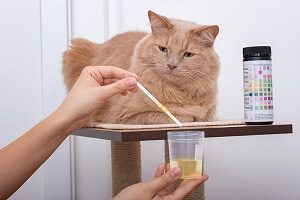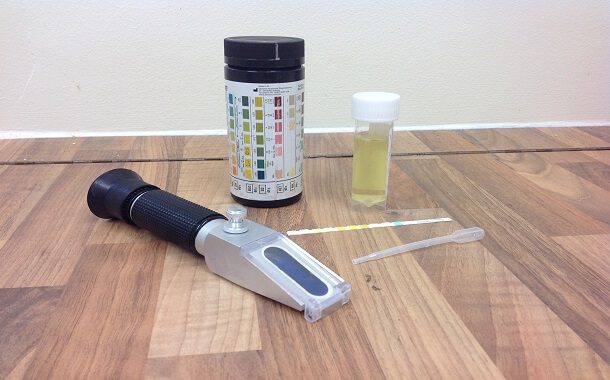How Much Does Cat Urinalysis Cost?
Last Updated on November 23, 2023
Written by CPA Alec Pow | Content Reviewed by ![]() CFA Alexander Popinker
CFA Alexander Popinker
Urinalysis is a simple, cheap, fast, and non-invasive method for your pet that can provide important information about the health and integrity of not only the urinary tract but also other vital organs.
Urinalysis is a laboratory test of urine. The urine is evaluated in terms of highlighting the presence of certain chemical substances. A microscopic examination of the urine is also performed to detect any abnormalities.
How Much Does Cat Urinalysis Cost?
Depending on how the procedure is done, the average cost of cat urinalysis would be anywhere between $50 and $85. The costs will be much lower if you bring in a sample instead of having the veterinarian collect the sample in the clinic. This price range will not include any other additional tests that the vet will also ask for, medication prescribed, and the office visit cost. When you also take into consideration these expenses, the total costs would be anywhere between $100 and $240.
You might also like our articles about the cost of cat tooth extraction, blood work for a cat, or cat abscess treatment.
How is the feline Urinalysis performed?
A urinalysis is initiated with the collection of the urine sample. Urine can be obtained using one of the three methods:
- Cytocentesis is a very frequently used method for collecting urine samples. This method involves inserting a needle directly into the bladder through the abdominal wall. This is a relatively quick and painless procedure. The cat can be laid down or left standing. The bladder is palpated (felt) and the needle is inserted into it.
- Catheterism (probing) consists of inserting a flexible plastic/silicone tube through the urethra and then into the urinary bladder (the reservoir located inside the body where the urine is stored until the animal urinates).
- Free-caught/collected urine samples are obtained by taking the sample when the cat urinates. The method is easy for some cats and quite difficult for others. Plastic containers, glasses, or different objects can be used. The container must be as clean as possible to obtain the most correct results. This method is the least “sterile” and is associated with the most errors in laboratory results.
Most veterinary medical centers have the necessary equipment to perform a urinalysis, but some choose to send their samples for examination to external, specialized laboratories.
A urinalysis generally takes around 30-40 minutes.
Is it necessary to sedate or anesthetize the patient to perform a urinalysis?
Neither sedation nor anesthesia is necessary for most patients. However, some pets get the bladder and urethra irritated by the placement of a catheter (probe), so they may require sedation or ultra-short anesthesia.
Is urinalysis painful?
 Whether the urinalysis is painful or not, depends on the method by which the urine is obtained.
Whether the urinalysis is painful or not, depends on the method by which the urine is obtained.
Catheterism (probing) is “uncomfortable” for most cats, especially for cats that don’t really tolerate the procedure. Females are very difficult to probe due to the anatomical location of their urethra. The survey is rarely performed on female cats.
If the urine is obtained by cystocentesis, the inoculation of the needle through the skin may be associated with short-term pain, as in the case of any other injection.
What Does a Urinalysis Reveal?
The urinalysis helps evaluate the function of the kidneys and the quality of the urine produced. As a rule, a urine analysis consists of three parts: the physical examination of the sample, a urine strip that evaluates the presence of certain substances (urinary biochemistry), and the microscopic examination of the urinary sediment.
A urinalysis can reveal pyuria (white blood cells in the urine), hematuria (blood in the urine), crystalluria (crystals in the urine), the presence of abnormal amounts of glucose, ketones, and proteins, and the degree of urine concentration.
What are the additional costs?
In case any abnormalities are detected during the exam, you will have to consider the costs of the immediate/future treatment options and/or antibiotics. Most probably the cat will need urgent surgery if there is a bacterium or worse, crystal formation or a blockage in the urinary tract.
Cat urinary tract infection treatment may include antibiotics, which take around 14 days to show their full effects. If the antibiotics are not working some type of therapy can be recommended.
Expect to pay more at an emergency vet clinic than at a regular vet office. The costs can go up by 30% or even more if the testing is performed after hours.
Does a pet insurance plan cover urinalysis in cats?
If your cat shows signs of a urinary tract infection or other issues requiring a first-time urine test, this will typically be covered by insurance.
Some insurance wellness packages will cover part of annual urinalysis as preventative care for senior cats.
Important things to consider
Urinalysis is indicated for the evaluation of pets with urinary problems such as polyuria (increased urine production), increased urination frequency, difficulty in urination, lack of urination, urine with blood, or any other color than normal.
This test proves useful in cases of unexplained fever, loss of appetite, or weight loss. A urinalysis is often performed when indicated by the results of an X-ray or ultrasound, blood tests that suggest a problem with the urinary system or other systems in the body, or as a result of clinical examination when abnormalities are detected.
How can I save money?
We already mentioned above that a cat urinalysis is more expensive if the vet inserts a tube to collect the sample. So, try to get a sample before going to the vet’s office.


Leave a Reply
Want to join the discussion?Feel free to contribute!